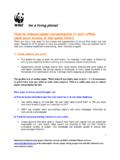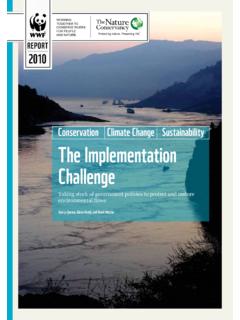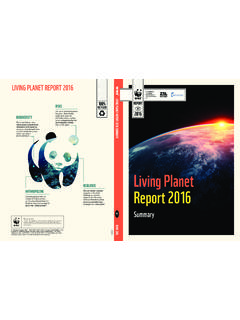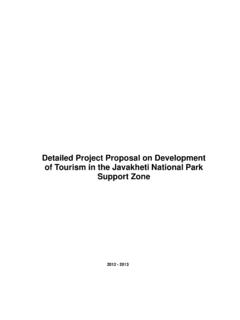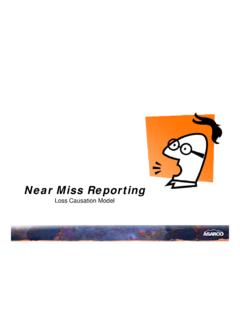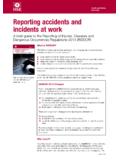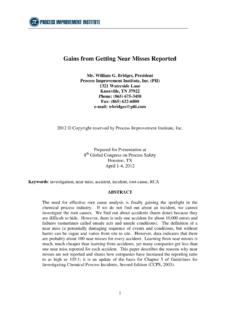Transcription of Interim Report: A review of 15 Years of Shipping …
1 15 years of shipping Accidents: A review for WWF Southampton Solent University Authors: Nickie Butt(a) Professor David Johnson(b) Pike(c) Nicola Pryce-Roberts(d) Natalie Vigar(e) (a,,c,d,e)Southampton Solent University, School of Maritime and Technology, East Park Terrace, Southampton SO14 0YN, UK +44 (0)2380 319000 (b) OSPAR Commission/ Bonn Agreement, Victoria House, 37-63 Southampton Row, London WC1B 4DA, UK +44 (0) 20 7430 5200 2 Executive Summary Shipping accidents, many involving spills of mineral oil, have been a catalyst for environmental protection regulation over the past 40 Years . Environmental risk is linked to the type and amount of oil and/or hazardous substances being carried and the sensitivity of the marine area where any accident happens.
2 A clear link can be made between environmental protection and Shipping safety, with Shipping accidents, often the subject of dramatic media coverage, provoking a strong response from civil society and politicians. 2012 has been a significant year for Shipping safety issues. The IMO used Maritime Day (2012) to mark the 100 year anniversary of the sinking of the Titanic and as a watershed of safety at sea. Recent Shipping incidents such as the Hebei Spirit and MV. Rena, and the 10th year anniversary of the sinking of the Prestige (2002) further highlight the need to identify and understand the factors contributing to Shipping accidents. These incidences among others renew the spotlight on the main causes of Shipping accidents, including the role played by flag States.
3 Despite the continual increase in the world s Shipping fleet a decrease in overall numbers of Shipping accidents has been seen over the last few decades. Whilst the data shows that poorly performing flag States are still an associated factor, there are other criteria that also strongly contribute to accidents, including: vessel age, vessel type, area of operation and challenging sea states (linked to the most common incident type foundering) and vessel size. Behind these criteria there are layers of administrative complexities within the Shipping industry which are connected to port and flag State control, flag registration and ratification of IMO conventions.
4 Economic factors also have an impact on Shipping safety, such as turn-around times and use of the minimum number of crew required to handle a vessel which often has implications such as staff working whilst fatigued. The key criteria contributing to Shipping accidents have been researched for this report through an extensive review of the world s casualty statistics over the past 15 Years and a review of all the port State Control Agreements and Memorandums of Understanding. More specific examples were drawn from a review of current literature to provide context and the wider picture. The research statistics were then verified through interviews with six expert industry stakeholders including a major European Shipping insurer, the MAIB, the IMO, Lloyds Register, a Naval Architect and an English P and I club from the International Group.
5 These criteria, and complexities associated with Shipping accidents and the industry generally were also examined, including insurance and underwriting requirements, the role of IACS, port State control and class societies. This is one of the first independent studies to look in detail at the collective data associated with Shipping accidents. The report produces consolidated evidence of factors that have contributed to Shipping accidents over the last 15 Years . This time period includes maritime disasters such as the Prestige and Erika incidents, which subsequently provoked changes in maritime safety regulations, which are 3 graphically summarised in the report as a timeline.
6 The report highlights areas of concern and contributory factors to Shipping accidents as well as the general implications these incidents have on the marine environment. The report focuses in particular on the issues surrounding the role of flag States and the extent of their responsibilities with respect to vessel safety and the implementation of international regulations. The evidence confirms that the majority of accidents can be linked with older vessels, a predominance of general cargo carrier accidents and a suite of worst performing flags. By far the most common accident is that the ship founders. However it is also encouraging that an outcome of this report is also confirmation of an overall improvement in vessel safety standards and a reduction of Shipping accidents relative to the growth of the world fleet.
7 This reflects the development of technology ( electronic charts), the success of enforcement regimes ( Port State control), and cooperative prevention efforts such as HELCOM Response (HELCOM, nd.) and the Bonn Agreement (Bonn Agreement, 2012). Nevertheless accidents still occur regularly and the need to address and re-assess the related underlying issues remains if future incidents are going to be avoided or reduced. Even small scale accidents in very sensitive environments can have profound environmental consequences ( MV. Pallas). Climate change predictions are likely to exacerbate the causes of foundering: storm surge, changing wind/wave climates, extreme weather events.
8 Furthermore there is a danger of complacency in the absence of a recent major accident and whilst much can be inferred from the accident statistics, such data can belie all manner of near misses. In light of the issues highlighted in the report, several recommendations are made. These include support for a more cohesive approach towards Shipping safety through encouragement of ratification of IMO and environmental conventions; balancing port and flag State responsibilities; globalised, standardization of reporting mechanisms associated with the collection of Shipping accident data; transparency and access to this information; encouragement of data sharing and of best practice concerned with safety procedures within the industry; research and collaborative work to keep older sea going vessels classed with IACS class societies.
9 These recommendations are particularly pertinent in light of the continued growth of the worlds Shipping fleet, as the economic crisis influences the number of ageing ships transporting high risk products and with the likely growth of vessels trading and operating in the sensitive Arctic region. 4 Contents Executive Summary p. 2 Introduction p. 6 Purpose of the report p. 7 Data Sources p. 7 MOUs p. 8 Interviews p. 8 Flag States p. 9 What is a Flag of Convenience? p. 9 Open Registers p. 10 Why do Flag States exist at all? p. 11 What are the registration requirements and formalities?
10 P. 14 Port State Control Inspections p. 16 Regional Port State Control Agreements p. 16 Ship selection criteria p. 17 Hiding corporate identity p. 18 Shipping accidents as drivers of maritime legislation p. 18 Current Trends/ Data presentation p. 21 Growth of the world fleet p. 21 Total losses by incident type p. 24 Losses by geographical area p. 25 Losses by average age of vessel p. 29 Losses by vessel type p. 29 Losses by registration p. 30 Losses as a percentage of registered fleet p. 32 Information from the MOUs p. 33 Discussion and key messages from the data p. 40 Key messages p.

